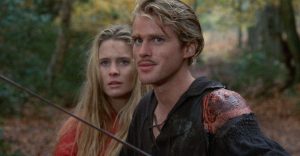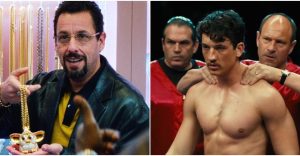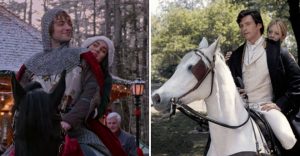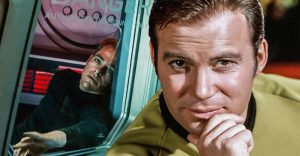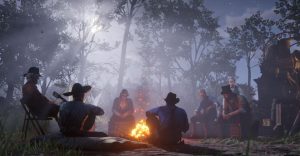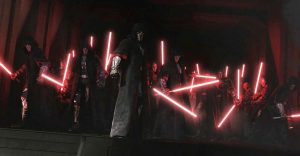20 Mind-Blowing Things You Didn’t Know About The Hobbit Trilogy

A rarity among global blockbusters, Peter Jackson’s Lord of the Rings trilogy was an example of fine filmmaking crossing over with big budget adventure. Technically sound with fantastical cinematography and beautifully crafted set designs, Jackson’s adaptation showed a deep admiration for the literary work of J.R.R. Tolkien. Jackson’s efforts were the result of three and a half years of preparation with drawn out displays and multiple collaborations that all melded together to create the trilogy we know today.
On the opposite side of the coin, we have LotR’s companion trilogy, a saga which many fans wish had never happened. A rushed production that was never meant to be; Peter Jackson was thrown into The Hobbit, but he wasn’t prepared to take on the challenge.
There’s a lot that went into picking apart one of Tolkien’s master works. From extending a single novel into a three film disaster to adding characters that were never part of Tolkien’s original vision, it’s dizzying just to think about all that went wrong with the Hobbit trilogy. Still, there’s a lot of things even die-hard fans don’t know about the the saddening saga, so join us as we take a look at 20 Shocking Things You Didn’t Know About the Disappointing Hobbit Trilogy.
20 Jackson wanted to make The Hobbit before LOTR

In 1994, Peter Jackson was deemed “one to watch: by Hollywood’s most renowned movie critics. Heralded as one of the most imaginative up-and-coming filmmakers, he received glowing reviews for his fantastical re-imagining of the Parker-Hulme murder case in the film Heavenly Creatures. The following year as he was putting his final touches on his latest movie The Frighteners, Jackson reached out to Miramax with an offer to recreate Middle-earth into a series of films.
According to Jackson, the idea began after the director watched the 1978 Lord of the Rings animated movie. As part of his vision, he told now-disgraced producer Harvey Weinstein about his intentions to make a trilogy, beginning with a solo Hobbit movie and two subsequent LotR films. Ultimately, a snag in rights negotiations stalled the project and it would be years until Jackson was finally given the opportunity to revisit the idea.
19 Why Guillermo del Toro left The Hobbit

When director Guillermo del Toro was first announced as Peter Jackson’s Middle-earth successor, fans anticipated a new visionary tale from the mind of one of cinema’s most imaginative fairy tale creators. Instead, after two and a half years of working in collaboration with Peter Jackson to bring Tolkien’s story to life, del Toro exited The Hobbit without much explanation.
Behind the scenes, not everything was coming up roses for the production crew. Production company Metro-Goldwyn-Meyer, who owned partial rights to make the films, was struggling to pay back massive amounts of debt, leaving The Hobbit’s future in jeopardy. Meanwhile, recent legal disputes between New Line Cinema and the Tolkien Estate about the rights of Tolkien’s material did little to cool the flames. With the project halted, del Toro walked away leaving fans curious about what his movies would have looked like.
18 Bilbo wasn’t cast until 6 weeks before shooting began

Six weeks before the start of The Hobbit’s principal photography date, Peter Jackson was in a state of panic about who would play Bilbo. Rumors were swirling online about potential candidates, but according to the director, there was only one actor on his radar. Having watched Martin Freeman on the UK version of The Office, he had become a fan of the actor’s “stuffy, repressed English quality,” but before negotiations could be made, Freeman signed on to play Watson in BBC’s version of Sherlock.
Fearful that another actor may be cast, some notable stars were reported to be up for the challenge with names like Daniel Radcliffe and James McAvoy emerging as frontrunners. At other times, Shia LaBeouf, Erryn Arkin, Tobey Maguire and Eddie Redmayne were also attached to the project, but ultimately Jackson got his wish and was able to hold out until his first choice became available.
17 Director Gollum

Out of the frying pan and into the fire, Martin Freeman was thrust headfirst into a 266 day long production. As a way of familiarizing himself with the character, his first scene would be opposite Andy Serkis as Bilbo ran into the crazed Gollum in the heart of the Misty Mountains. Thanks to advances in motion capture technology, the two acted alongside one another, filming in long takes set up like a stage play.
Though all of Serkis’ scenes were recorded within a week, the actor wasn’t quite ready to give up his hold on Middle-earth. As a result, he stayed on to help Jackson complete the first film, serving as a second unit director for several sequences, including many pivotal battle scenes.
For Serkis, the dual role gave the actor a whole new appreciation for the trilogy, and were the first steps to his taking on solo director roles for Breathe and The Jungle Book.
16 Frame-rate made the movie look weird

As a pioneer in cinematic technology, Peter Jackson pushed the envelope in the Hobbit franchise with his decision to film the trilogy in 48 frames per second. At a rate twice as fast as the industry standard, the move was a clear one for Jackson, who worried that jerky character movements would distract fans during the film’s action scenes. The new frame rate was meant to provide a clearer image, but in the end, many fans despised the change.
Intended as a more immersive experience, the critics of the new frame rate weren’t keen on how artificial the movie appeared. Although the images were clearer, there was something unappealing about how the movie looked with many people stating it appeared too much like a behind-the-scenes tour of a movie set. Still, Jackson stood by his decision, insisting the new rate would someday become the industry standard.
15 Shooting alone on a green screen made Ian McKellan cry

With the Lord of the Rings trilogy, Peter Jackson brought a newfound appreciation to the world of optical illusions. Working behind the camera, he used forced perspective when Sir Ian McKellan was on set to make Gandalf appear noticeably larger next to the Hobbits. McKellan was positioned closer to the camera to make him appear larger on screen. It was an unusual method that used no CGI effects.
The on-set experience for TheHobbit was admittedly more tedious for McKellan. Rather than shooting alongside his co-stars, he was put in front of a green screen. The actor was so overwhelmed by the isolating set that he broke down in tears, unaware that his mic was on. In the end, his co-stars helped him through the transition, but it’s unlikely McKellan will volunteer for a similar project down the road.
14 No Human lead characters?

Adding to the otherworldly aspect of Tolkien’s novels, An Unexpected Journey marked several firsts for the Middle-earth franchise. Not only did the main cast mainly consist of Dwarves, but it was the first time that a human wasn’t given a speaking role in Tolkien’s world. Although the Race of Men were shown in the opening sequence, none of them talk, putting all the emphasis on the world’s more fictitious characters.
13 A little girl voiced Smaug’s roar

A long-awaited antagonist of the big screen, a lot went into developing one of fiction’s fiercest dragons: Smaug. As the King Under the Mountain, Smaug laid waste to the Dwarf kingdom of Erebor and took ownership of their great wealth, so when it came time to create the fearsome snarls and bellows of the ghastly beast, sound designer David Farmer searched far and wide for inspiration.
According to Farmer, many of Smaug’s battle cries came from unexpected places, including the distorted sounds of a hungry pig that Farmer recorded early one morning, but even more surprising is the fact that Farmer’s daughter also provided vocals.
As the story goes, Farmer was invited to a Career Day for his daughter’s first grade glass. When he asked his daughter to roar for the class, he recorded her voice, which he later inserted into the trilogy as part of Smaug’s overall sound.
12 Unnecessary Azog

Rather than depicting the villain through flashbacks, Jackson inexplicably revived the character, setting a background story in which Thorin removed the villain’s arm. Azog then proceeds to give chase to the Dwarves for the entirety of the trilogy. While the change gives a sense of urgency to the narrative, it’s too far removed from Tolkien’s story and too reminiscent of Lurtz from LotR to add anything new to the Middle-earth franchise.
11 The stars’ Five O’Clock Shadow required constant touch-ups

With the use of new technology comes unexpected surprises. With a new 48fps camera rate on full display, the behind-the-scenes crew ran into some odd problems on screen. While filming a scene, the actors’ prosthetics would appear visibly yellow as if the entire cast had jaundice. To correct the mistake, the make-up department worked around the clock to touch up the cast with red hues to look camera ready.
Although the crew were ultimately able to fix the minor prosthetics issue, another problem soon arose with the male actors on set. Due to the long hours of filming each day, the men would have five o’clock shadow by day’s end, which often appeared blue in front of the camera. This too had to be corrected with constant touch-ups, showing the strain that the makeup crew went through to get Tolkien’s characters just right.
10 Yak Hair Everywhere

As a honorable and proud people, the Dwarves are an essential part to Tolkien’s story, so when it came to make-up and hair, everything had to look spot on. Going through four tons of silicon to cast each actor’s face, the crew at WETA Workshop worked tirelessly to recreate Peter Jackson’s vision. Ultimately, however, it was the cast’s hair that proved to be challenging.
Made from water resistant yak hair, the beards and wigs for Thorin’s crew became a problem when the cast were asked to stay in water for hours on end during the barrel escape sequence in The Desolation of Smaug. In the heat of battle with both the Orcs and the Elves, the crew were forced under raging tides. The only problem was their hair wouldn’t stay wet. As a solution, the crew went through pots of hair gel in order to get the desired effect.
9 Benedict Cumberbatch: crawling like a lizard and speaking backward

Actors often go through extremes to get into character, whether it’s bulking up for a role or spending countless hours studying their subject as closely as possible. For Benedict Cumberbatch, who both voiced the role of Smaug and provided his movements via motion-capture technology, this preparation meant visiting the London Zoo regularly to observe the reptilian exhibits in their natural habitat. According to the actor, he took notes on how the lizards and Komodo dragons moved about, patterning his look after them.
Apart from playing the slithering dragon under the mountain, Cumberbatch also provided vocals for the Necromancer. In order to reach the inhuman quality of the antagonist’s voice, Cumberbatch recited his lines of Black Speech backwards, memorizing each one accordingly and asking to have them played back in reverse to create an otherworldly effect. Cumberbatch would later compare the experience to the feeling of performing a Satanic ritual.
8 Evangeline Lilly hated Tauriel’s love story

Despite being enthusiastic about the part, Lilly later showed signs of regret thanks to some studio interference. According to the actress, she only accepted the role with one stipulation. No matter the situation, she didn’t want to be forced into another cringe-worthy love triangle. After shooting for a year, she returned to the set only to find changes to the script which included Tauriel being caught in a love story with Kili and Legolas.
7 Legolas doesn’t blink?

As one of the eldest members of the Fellowship, Legolas was a master archer and skilled fighter who defied the laws of gravity. Like his ancestors before him, he was graceful yet strong and rarely showcased his emotions for his fellow brethren, though he felt deeply for those he cared most about. This small detail meant that Legolas rarely blinked on screen, a fact fans are quick to point out.
Keeping with the continuity of Jackson’s first three movies, Legolas hardly moves his eyelids in the Hobbit movies, only blinking when he is injured. In fact, Battle of the Five Armies is the only movie in which Legolas can be seen blinking consistently, possibly due to the movie taking place almost entirely during the battle where he was either hurt or strained. Still, it’s a crazy attention to detail that only a dedicated filmmaker like Jackson would pay attention to.
6 Don’t Drink the Yellow Water

There are few scenes in Peter Jackson’s version of Middle-earth that fully capture the escapism of Tolkien’s novels better than the Dwarves’ wine barrel escape from the Elves of Mirkwood in The Desolation of Smaug. The seven-minute escape sequence quickly transitions from a high-intensity chase scene to one of the trilogy’s more visually intense battle sequences, but despite being one of the few highlights of the trilogy, it wasn’t all fun on set.
Editing down 98 hours of footage from aerial shots, green screen sets and live-action shoots, the cast spent days inside a specially constructed indoor rapids tank with breaks coming few and far between. As a result, many of the actors admitted to relieving themselves in the water, a fact which later angered Martin Freeman, who spent almost all his time in the water and even swallowed some of it.
5 A Very Troubled Production

In what can best be described as the world’s most honest promotional video, Peter Jackson spilled the beans on what went wrong behind the scenes of the Hobbit trilogy that left fans divided on the films. Featured as a bonus on the Battle of the Five Armies blu-ray, Jackson’s tell-all begins with confessing that he had no idea what he was doing on set.
Coming in after the departure of Guillermo Del Toro, Jackson was thrust into the production without any prep time. Unlike LotR, which was mapped out for three and a half years, the Hobbit films were made on the fly with the crew working day in and day out to deliver new costumes and set pieces each morning.
By the end of the trilogy’s climactic battle, Jackson was left to make things up, which inevitably caused the quality of the films to suffer.
4 The unplanned third movie was originally Rated R

Before filming commenced on the 266 day production of the Hobbit trilogy, Peter Jackson planned to only make two films total. It wasn’t until deep into the process that he realized the extent of footage he had filmed. During production, he announced that the third act would receive its own release under the subtitle of The Battle of the Five Armies.
At a total run time of 2 hours 44 minutes, the third Hobbit film is easily Jackson’s shortest Middle-earth adventure, but an extended release of the movie revealed a few key changes that barely kept the last film from earning an R rating.
As the first R-rated Middle-earth film and Jackson’s first R-rated movie since The Frighteners, the extended version of Battle of the Five Armies features heavier violence, including a few grisly images that turn up the bloodshed during the fantastical Battle of Erebor.
3 One Seriously High-Tech Dragon

With the release of The Desolation of Smaug, the Middle-earth franchise once again continued its trend of Academy Award nominated movies that were heralded for their special effects work. Working alongside his long-time collaborators at WETA, Peter Jackson and the special effects team were able to transform the literary lizard Smaug into a stunning on-screen antagonist of epic proportions.
Breaking down the character to the finest of details, everything from the dragon’s individual scales to the membranes on his wings were conceptualized and animated. In the end, it would have taken a full week for a normal home computer to render one of Smaug’s scales.
Luckily, the crew was working with over 50,000 CPU cores and 170 terabytes of ram, which equaled the power of 30,000 average computers and allowed them to run things a lot smoother despite the epic task at hand.
2 Gold, Gold & More Gold

With all the computer-rendered imagery and intricately textured graphics that went into Tolkien’s world, it’s easy to overlook the extreme attention to detail that went into making the beautifully crafted set designs. More than just a special effects designer, WETA also put together some of the practical effects that went into some of The Hobbit’s more extravagant pieces, including the gold and gems that filled Smaug’s lair.
Using gold paint to achieve the proper aesthetic, Smaug’s lair reportedly used up so much of the liquid gold that the film completely exhausted New Zealand’s supply. To continue with their lavish set design, more of the precious commodity had to be imported from Germany. Luckily, they were able to get their hands on enough of the stuff to complete the look, but we’re sure there were plenty of arts and crafts stores in New Zealand left with some explaining to do.
1 Even More Money

It’s no secret the Middle-earth franchise is one of the most lucrative movie franchises in history. In 2013, An Unexpected Journey became just the fifteenth film to cross the coveted threshold of one billion dollars, but which of the two Peter Jackson-directed sagas brought home the most cash?
Collectively, the Middle-earth movies have earned a whopping $5.84 billion, but some fans may be shocked to find that the less critically-acclaimed saga brought in more. At a total of $2.932 billion compared to the LotR’s $2.917 billion, The Hobbit narrowly surpassed its predecessor.
Although the second trilogy comes in as the bigger money-maker, it’s important to note it had a higher production cost. While the production cost of the LotR was $281 million, The Hobbit was more than twice that at $675 million, meaning LotR is still king at the end of the day.
—
Do you have any The Hobbit trivia to share? Leave it in the comments!











